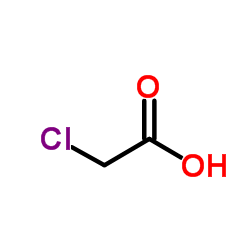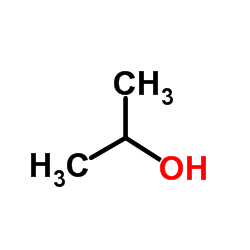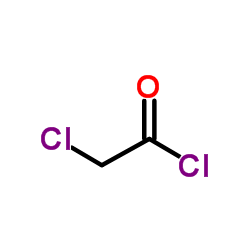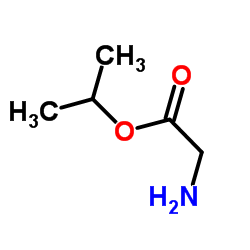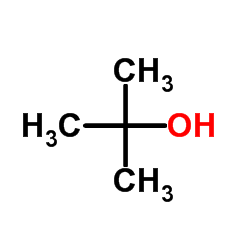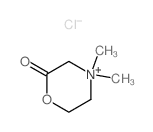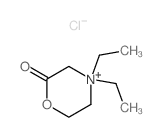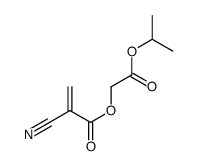105-48-6
| 中文名 | 氯乙酸异丙酯 |
|---|---|
| 英文名 | Isopropyl Chloroacetate |
| 中文别名 | 氯醋酸异丙酯 |
| 英文别名 |
Chloroacetic Acid Isopropyl Ester
Iso-propyl chloroacetate Monochloroacetic acid isopropyl ester Acetic acid, chloro-, isopropyl ester (8CI) propan-2-yl 2-chloroacetate Isopropyl chloroacetate EINECS 203-301-7 MFCD00040410 Acetic acid, 2-chloro-, 1-methylethyl ester |
| 密度 | 1.1±0.1 g/cm3 |
|---|---|
| 沸点 | 149.0±8.0 °C at 760 mmHg |
| 熔点 | -112ºC |
| 分子式 | C5H9ClO2 |
| 分子量 | 136.577 |
| 闪点 | 49.5±9.1 °C |
| 精确质量 | 136.029114 |
| PSA | 26.30000 |
| LogP | 1.29 |
| 外观性状 | 一种透明无色液体 |
| 蒸汽压 | 4.1±0.3 mmHg at 25°C |
| 折射率 | 1.417 |
| 储存条件 | 储存于阴凉、通风的库房。远离火种、热源、防静电。应与氧化剂、强碱分开存放,切忌混储。配备相应品种和数量的消防器材。储区应备有泄漏应急处理设备和合适的收容材料。 |
| 稳定性 | 避免与氧化剂接触。 |
| 水溶解性 | SLIGHTLY SOLUBLE |
| 分子结构 | 1、 摩尔折射率:31.79 2、 摩尔体积(cm3/mol):126.3 3、 等张比容(90.2K):291.6 4、 表面张力(dyne/cm):28.4 5、 介电常数: 6、 偶极距(10-24cm3): 7、 极化率:12.60 |
| 计算化学 | 1.疏水参数计算参考值(XlogP):1.5 2.氢键供体数量:0 3.氢键受体数量:2 4.可旋转化学键数量:3 5.互变异构体数量:无 6.拓扑分子极性表面积26.3 7.重原子数量:8 8.表面电荷:0 9.复杂度:80.5 10.同位素原子数量:0 11.确定原子立构中心数量:0 12.不确定原子立构中心数量:0 13.确定化学键立构中心数量:0 14.不确定化学键立构中心数量:0 15.共价键单元数量:1 |
| 更多 | 1. 性状:液体。 2. 密度(g/mL,25℃):1.08 3. 相对密度(20℃,4℃):1.0888 4. 相对密度(25℃,4℃):1.0812 5. 沸点(ºC,常压):149-150 6. 常温折射率(n20):1.4192 7. 折射率:1.418-1.42 8. 闪点(ºC):56 9.常温折射率(n25):1.4175 10. 自燃点或引燃温度(ºC): 未确定 11. 蒸气压(mmHg,20ºC):未确定 12. 饱和蒸气压(kPa, ℃):未确定 13. 燃烧热(KJ/mol):未确定 14. 临界温度(ºC):未确定 15. 临界压力(KPa):未确定 16. 油水(辛醇/水)分配系数的对数值:未确定 17. 爆炸上限(%,V/V):未确定 18. 爆炸下限(%,V/V):未确定 19. 溶解性:略溶于水。 |
Synonym:(1-Methylethyl)-2-Chloroacetate Section 2 - COMPOSITION, INFORMATION ON INGREDIENTS
Risk Phrases: 10 Section 3 - HAZARDS IDENTIFICATION EMERGENCY OVERVIEW
Flammable.The toxicological properties of this material have not been fully investigated. Potential Health Effects Eye: May cause eye irritation. Skin: May cause skin irritation. Ingestion: May cause irritation of the digestive tract. The toxicological properties of this substance have not been fully investigated. Inhalation: May cause respiratory tract irritation. The toxicological properties of this substance have not been fully investigated. Vapors may cause dizziness or suffocation. Chronic: No information found. Section 4 - FIRST AID MEASURES Eyes: Immediately flush eyes with plenty of water for at least 15 minutes, occasionally lifting the upper and lower eyelids. Get medical aid. Skin: Get medical aid if irritation develops or persists. Wash clothing before reuse. Flush skin with plenty of soap and water. Ingestion: Do not induce vomiting. If victim is conscious and alert, give 2-4 cupfuls of milk or water. Never give anything by mouth to an unconscious person. Get medical aid immediately. Inhalation: Remove from exposure and move to fresh air immediately. Get medical aid if cough or other symptoms appear. Do NOT use mouth-to-mouth resuscitation. If breathing has ceased apply artificial respiration using oxygen and a suitable mechanical device such as a bag and a mask. Notes to Physician: Section 5 - FIRE FIGHTING MEASURES General Information: As in any fire, wear a self-contained breathing apparatus in pressure-demand, MSHA/NIOSH (approved or equivalent), and full protective gear. Vapors may form an explosive mixture with air. Vapors can travel to a source of ignition and flash back. During a fire, irritating and highly toxic gases may be generated by thermal decomposition or combustion. Will burn if involved in a fire. Use water spray to keep fire-exposed containers cool. Containers may explode in the heat of a fire. Flammable liquid and vapor. Vapors may be heavier than air. They can spread along the ground and collect in low or confined areas. Extinguishing Media: For small fires, use dry chemical, carbon dioxide, water spray or alcohol-resistant foam. For large fires, use water spray, fog, or alcohol-resistant foam. Use water spray to cool fire-exposed containers. Water may be ineffective. Do NOT use straight streams of water. Section 6 - ACCIDENTAL RELEASE MEASURES General Information: Use proper personal protective equipment as indicated in Section 8. Spills/Leaks: Absorb spill with inert material (e.g. vermiculite, sand or earth), then place in suitable container. Avoid runoff into storm sewers and ditches which lead to waterways. Clean up spills immediately, observing precautions in the Protective Equipment section. Remove all sources of ignition. Use a spark-proof tool. Provide ventilation. A vapor suppressing foam may be used to reduce vapors. Section 7 - HANDLING and STORAGE Handling: Wash thoroughly after handling. Use with adequate ventilation. Ground and bond containers when transferring material. Use spark-proof tools and explosion proof equipment. Avoid contact with eyes, skin, and clothing. Empty containers retain product residue, (liquid and/or vapor), and can be dangerous. Keep container tightly closed. Keep away from heat, sparks and flame. Avoid ingestion and inhalation. Do not pressurize, cut, weld, braze, solder, drill, grind, or expose empty containers to heat, sparks or open flames. Storage: Keep away from heat, sparks, and flame. Keep away from sources of ignition. Store in a tightly closed container. Store in a cool, dry, well-ventilated area away from incompatible substances. Flammables-area. Section 8 - EXPOSURE CONTROLS, PERSONAL PROTECTION Engineering Controls: Facilities storing or utilizing this material should be equipped with an eyewash facility and a safety shower. Use adequate ventilation to keep airborne concentrations low. Exposure Limits CAS# 105-48-6: Personal Protective Equipment Eyes: Wear appropriate protective eyeglasses or chemical safety goggles as described by OSHA's eye and face protection regulations in 29 CFR 1910.133 or European Standard EN166. Skin: Wear appropriate protective gloves to prevent skin exposure. Clothing: Wear appropriate protective clothing to prevent skin exposure. Respirators: Follow the OSHA respirator regulations found in 29 CFR 1910.134 or European Standard EN 149. Use a NIOSH/MSHA or European Standard EN 149 approved respirator if exposure limits are exceeded or if irritation or other symptoms are experienced. Section 9 - PHYSICAL AND CHEMICAL PROPERTIES Physical State: Liquid Color: clear, colorless Odor: Not available. pH: Not available. Vapor Pressure: 68 mm Hg @20C Viscosity: Not available. Boiling Point: 149 - 150 deg C @ 760.00mm Hg Freezing/Melting Point: -112 deg C Autoignition Temperature: Not available. Flash Point: 56 deg C ( 132.80 deg F) Explosion Limits, lower: Not available. Explosion Limits, upper: Not available. Decomposition Temperature: Solubility in water: slightly soluble in water Specific Gravity/Density: 1.0850g/cm3 Molecular Formula: C5H9ClO2 Molecular Weight: 136.57 Section 10 - STABILITY AND REACTIVITY Chemical Stability: Stable at room temperature in closed containers under normal storage and handling conditions. Conditions to Avoid: Incompatible materials, ignition sources, excess heat. Incompatibilities with Other Materials: Strong oxidizing agents, strong bases. Hazardous Decomposition Products: Hydrogen chloride, carbon monoxide, carbon dioxide. Hazardous Polymerization: May occur. Section 11 - TOXICOLOGICAL INFORMATION RTECS#: CAS# 105-48-6 unlisted. LD50/LC50: Not available. Carcinogenicity: Isopropyl Chloroacetate - Not listed by ACGIH, IARC, or NTP. Section 12 - ECOLOGICAL INFORMATION Section 13 - DISPOSAL CONSIDERATIONS Dispose of in a manner consistent with federal, state, and local regulations. Section 14 - TRANSPORT INFORMATION IATA Shipping Name: ISOPROPYL CHLOROACETATE Hazard Class: 3 UN Number: 2947 Packing Group: III IMO Shipping Name: ISOPROPYL CHLOROACETATE Hazard Class: 3.3 UN Number: 2947 Packing Group: III RID/ADR Shipping Name: ISOPROPYL CHLOROACETATE Hazard Class: 3 UN Number: 2947 Packing group: III Section 15 - REGULATORY INFORMATION European/International Regulations European Labeling in Accordance with EC Directives Hazard Symbols: Not available. Risk Phrases: R 10 Flammable. Safety Phrases: S 9 Keep container in a well-ventilated place. S 16 Keep away from sources of ignition - No smoking. S 26 In case of contact with eyes, rinse immediately with plenty of water and seek medical advice. S 33 Take precautionary measures against static discharges. S 37/39 Wear suitable gloves and eye/face protection. S 45 In case of accident or if you feel unwell, seek medical advice immediately (show the label where possible). WGK (Water Danger/Protection) CAS# 105-48-6: No information available. Canada CAS# 105-48-6 is listed on Canada's NDSL List. CAS# 105-48-6 is not listed on Canada's Ingredient Disclosure List. US FEDERAL TSCA CAS# 105-48-6 is listed on the TSCA inventory. SECTION 16 - ADDITIONAL INFORMATION N/A |
|
生态学数据: 该物质对水有稍微的危害。
|
| 危害码 (欧洲) | T:Toxic; |
|---|---|
| 风险声明 (欧洲) | R10;R25;R36/37/38 |
| 安全声明 (欧洲) | S26-S37/39-S45 |
| 危险品运输编码 | UN 2947 3/PG 3 |
| WGK德国 | 1 |
| 包装等级 | III |
| 危险类别 | 3 |
| 海关编码 | 2915400090 |
|
~95% 
105-48-6 |
| 文献:Synthetic Communications, , vol. 37, # 5 p. 759 - 765 |
|
~83% 
105-48-6 |
| 文献:WO2009/130481 A1, ; Page/Page column 108 ; |
|
~% 
105-48-6 |
| 文献:Journal of the American Chemical Society, , vol. 56, p. 2689 |
|
~% 
105-48-6 |
| 文献:Rapid Communications in Mass Spectrometry, , vol. 27, # 3 p. 461 - 466 |
|
~% 
105-48-6 |
| 文献:Rapid Communications in Mass Spectrometry, , vol. 27, # 3 p. 461 - 466 |
|
~% 
105-48-6 |
| 文献:Tetrahedron Letters, , vol. 31, # 34 p. 4883 - 4886 |
|
~% 
105-48-6 |
| 文献:Journal of the American Chemical Society, , vol. 56, p. 2689 |
| 上游产品 8 | |
|---|---|
| 下游产品 10 | |
| 海关编码 | 2915400090 |
|---|---|
| 中文概述 | 2915400090 其他一氯代乙酸的盐和酯(包括二氯代乙酸或三氯代乙酸的盐和酯). 增值税率:17.0% 退税率:9.0% 监管条件:无 最惠国关税:5.5% 普通关税:30.0% |
| 申报要素 | 品名, 成分含量, 用途 |
| Summary | 2915400090 mono-, di- or trichloroacetic acids, their salts and esters |
